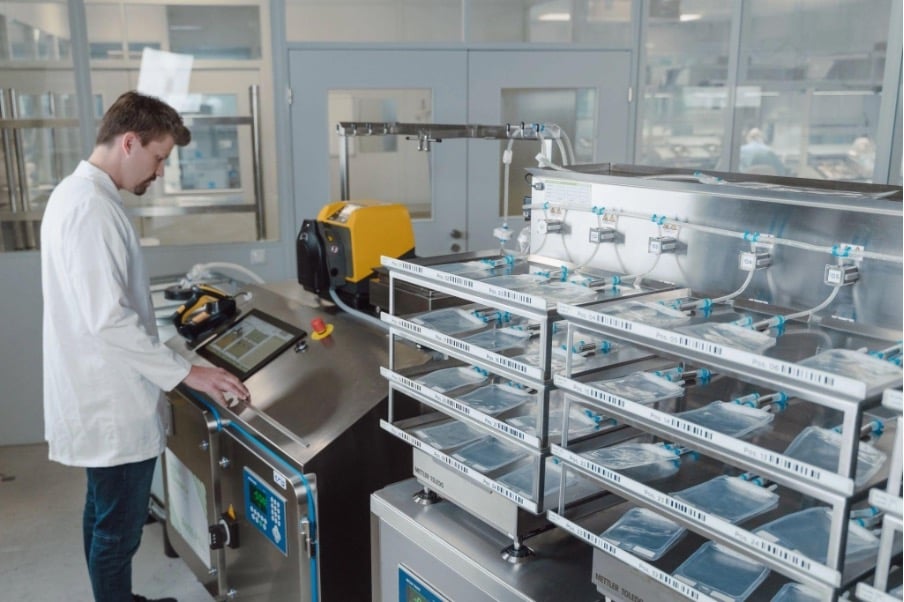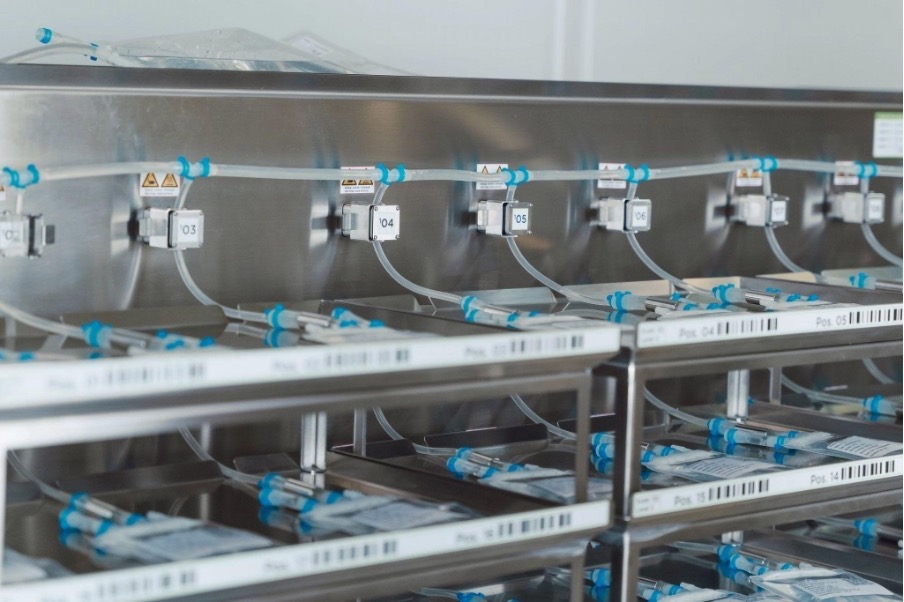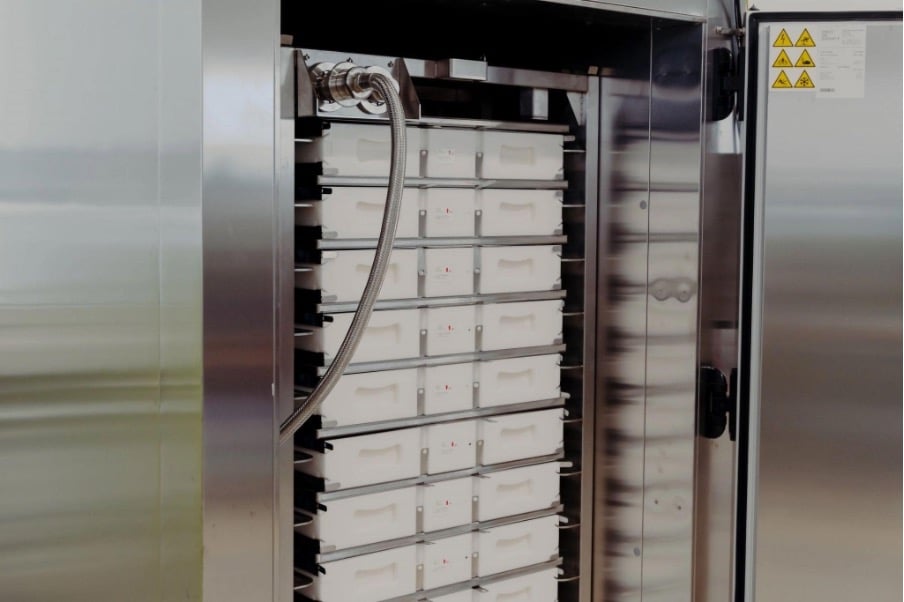
The term “safety” in the context of biopharmaceutical manufacturing is ambiguous: On the one side, it refers to the safe applicability of pharmaceutical products in clinical settings. The products not only have to be effective, but the risks for patients upon administration need to be predictable as well, which is why tolerability is one of the focal points in clinical studies. Additionally, manufacturers have to make sure that production methods are up to the required standard, as deviations may lead to severe consequences. For good reason, guidelines referring to cGMP standards are regularly adopted to keep pace with constant advancements in the pharma industry.
On the other hand, safety aspects also extend to the environment of drug production itself, as active pharmaceutical ingredients may be involved that are hazardous for both employees and the manufacturers. This, for instance, becomes obvious in the manufacturing of antibody-drug conjugates (ADCs): They are produced by combining a monoclonal antibody with a cytotoxic payload, the latter of which might cause severe health issues in case of exposure outside controlled clinical settings, respectively in a non-conjugated state.
This ambiguity makes it twice as crucial for biopharmaceutical manufacturers to ensure reliable and compliant production processes. End-to-end processes are being increasingly adopted to keep control over delicate manufacturing steps. However, thorough planning is necessary in advance to ensure safe, future-proof, and cost-effective production workflows.
Common Ground – Usual Phases in Biopharmaceutical Manufacturing
Type 2 diabetes injections, hormone substitutes, immunotherapies – the spectrum of drug products to which today’s medicine has access has never been wider or more diverse. Accordingly, countless different production methods are being used; however, when speaking of biopharmaceutical manufacturing, there are some overlaps that are worth reconsidering.
These similarities can be roughly grouped into steps revolving around fluid management and cold chain storage and transport. As for fluid management, liquids in different volumes often have to be transferred, filled, and filtered several times during manufacturing: this not only applies to the final drug products but also to fluid intermediates. Cell cultures, for instance, rely on exact and sterile fluid management and are a cornerstone in the production of biologics like therapeutic antibodies and other proteins.
Cold chain management is essential in advanced bioprocessing, as protein-based products have a relatively short shelf life compared to conventional drug products. Temperature management along the entire supply chain ensures that valuable drug products do not deteriorate before they can fulfil their intended purpose. However, rather than simply storing biologics in household refrigerators, pharmaceutical freezers have to provide advanced control over freezing and thawing rates and precise temperature monitoring. The necessary degree of cooling spans from refrigerated environments to cryogenic temperatures.

Closed processes are being adopted more and more in the fluid management of biopharmaceuticals. © Single Use Support
Biopharmaceutical Manufacturing: Why Hands-off is on the Rise
With pharmaceutical processes growing in scale more and more, there is a growing tendency to reduce manual handling and instead implement automated, closed processing. This is further stressed by regulations that increasingly require biomanufacturers to adopt automated processes instead of manual ones. When one considers the scaling of manual documentation alone, the requirements become time-consuming and complex.
Product cost in biopharma is, next to safety, yet another reason why product loss must be avoided. After all, 30 to 40% of the deviations encountered in the pharmaceutical industry can be traced back to some kind of human failure during operational handling.[1]
However, it is not only about reducing the number of human workers in cleanroom environments: Employees are increasingly hard to find, as specially trained employees are few and far between. That is another reason favouring pharma 4.0, where traditionally manual tasks are carried out automatically by cGMP-compliant fluid and cold chain management systems. Assembled as end-to-end systems, they provide a closed and safe environment for valuable biopharmaceuticals on their way from production to transport and storage.
Aseptic Fluid Management With Closed End-to-End Processes
Monoclonal antibodies, autologous stem cell transplantation, or allogeneic cell therapies – these biopharmaceutical products require aseptic fluid management. In many cases, closed processing is preferred over open processing to provide an uninterrupted fluid transfer process, accompanied by further downstream processing steps, such as filtration and homogenisation. The former underlies special regulatory requirements in aseptic processing, as manufacturers have to make sure that the filters that come into play are, in fact, both sterile and functioning.
In the European Union, for instance, EU GMP Annex 1 describes PUPSIT (Pre-Use Post-Sterilisation Integrity Testing) as a crucial step in the manufacturing of sterile goods: Different testing methods, from bubble point to pressure hold testing, may be chosen to assess the integrity of medical-grade filters as just one possible component of an aseptic fluid path – along with tubings, pumps, and containers.[2]
However, the precision and efficiency that can be achieved with automated fluid management systems are remarkable. Along with the elevated degree of safety (as direct exposure to potentially hazardous substances can be mitigated), this is a major reason why biopharma companies increasingly adopt them.

Many protein-based pharmaceuticals require advanced cold-chain management and respective systems. © Single Use Support
Cold Chain Management and Logistics – How to Keep Cool
Sterile manufacturing is one thing, but – in the case of protein-based pharmaceuticals and cell therapies – not enough. In fact, temperature control is yet another essential aspect to be considered by manufacturers, with noticeable shifts towards more and more professional systems.
Precision, consistency, reliability, and traceability are assets that characterise medical grade freezing and thawing solutions, considering the particular freezing protocols that are to be adhered to and that may vary significantly from product to product. For instance, a study has shown that freezing rates around -1 °C/minute can be considered ideal for mammalian cells – such as CHO cells, which are extensively used in the production of antibody products.[3]
Controlled rate freezing within closed systems also mitigates damaging effects related to freezing, such as cryoconcentration. Furthermore, closed systems allow precise temperature monitoring and prevent staff from being exposed themselves to ultra-cold temperatures – e.g. when manually freezing gene products with liquid nitrogen.
Temperature control is not limited to the actual manufacturing process; instead, it is equally vital during the storage and transport of biopharmaceuticals. Besides precision and traceability, efficiency in cold storage is key. Cold chain management requires space, energy, and resources. The space efficiency of chosen storage solutions, ensured by high storage density, energy efficiency, and the possibility to store bioprocess containers by different manufacturers, is therefore of utmost importance.
What Hinders End-to-End Processes From Being Adopted?
Regardless of the numerous benefits that come with end-to-end solutions in bioprocessing, they are not without challenges. Some are related to financial aspects, as initial setup costs have to be calculated. But the intricacies do not start here: Choosing the right system raises questions related to process validation, flexibility, and interoperability. Especially due to the costs associated with the implementation of end-to-end processes, future-proof solutions have to be customised. Furthermore, manufacturers need profound knowledge of their individual processes and also have to anticipate eventual changes within their routines in the near future.[4]
This also applies to scalability, as production volumes may change over time and require either scale-up or scale-down – ideally without having to replace the entire production setup. Furthermore, regulatory compliance and considerations upon sterility may concern biopharmaceutical manufacturers before implementing closed end-to-end solutions.
Where Pharmaceutical Processing is Heading
The rapid advancements in the biopharmaceutical sector prompt manufacturing strategies to evolve with them. To circumvent the challenges revolving around the implementation of closed processing environments, single-use technologies are emerging as a powerful vehicle to make end-to-end processing even more advantageous.
Single-use components, such as bioprocess containers, tubings, and filters, are part of a general trend to increasingly adopt single-use technologies in biopharma. This trend is driven by an increased level of sustainability, high cost-effectiveness and the reduced need for cleaning at the manufacturing site.[5]
Furthermore, modular systems are gaining popularity as they come with an elevated level of customisability and scalability. This way, single-use systems support biopharma companies in designing safe and GMP-compliant closed processes at any scale.
Conclusive Considerations
The pharmaceutical sector is confronted with numerous intricacies revolving around the safety of its products that must be solved for the sake of both employees and patients. While end-to-end processes come with advantages like elevated levels of sterility, traceability, and consistency, factors like initial setup costs, compliance, and scalability may hinder their implementation.
With the rise of single-use technologies, though, many of these challenges can be mitigated: Flexible, scalable, and customisable end-to-end systems based on single-use technologies can adapt to changing production environments and reduce the need for extensive cleaning and the amount of manual handling. This makes them promising technologies for the production of countless pharmaceutical products in an attempt to make them even more reliable, affordable, and safe.
This article is part of the HealthManagement.org Point-of-View Programme.
References:
[1] Mühlegger, M. (2022) "How Pharma 4.0 eliminates human errors in the pharmaceutical industry", Single Use Support. Available at: https://www.susupport.com/knowledge/pharma-4-0/pharma-eliminates-human-errors-pharmaceutical-industry (Accessed: 2024/4/4).
[2] European Commission. "Annex 1: Manufacture of Sterile Products". Available at: https://health.ec.europa.eu/system/files/2020-02/2020_annex1ps_sterile_medicinal_products_en_0.pdf (Accessed: 2024/4/4).
[3]Fuchs, A. (2024) "Study: Optimizing Cell Viability During CHO Cell Freezing". Available at: https://www.susupport.com/knowledge/cell-gene-therapy/study-optimizing-cell-viability-during-cell-freezing (Accessed: 2024/4/4).
[4] Dream, R. (2023) “End-to-End Biomanufacturing: Challenges and Opportunities in Implementation”, American Pharmaceutical Review. Available at: https://www.americanpharmaceuticalreview.com/Featured-Articles/597597-End-to-End-Biomanufacturing-Challenges-and-Opportunities-in-Implementation/ (Accessed: 2024/4/4).
[5] Eder, M. (2021) “Enhancing sustainability in the pharmaceutical industry with single-use technologies”, Single Use Support. Available at: https://www.susupport.com/knowledge/single-use-technology/enhancing-sustainability-pharmaceutical-industry-with-single-use-technologies (Accessed: 2024/4/4).






